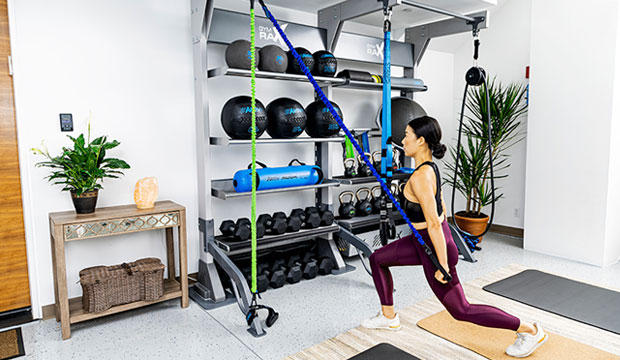The world of fitness and exercise has been fundamentally changed by the pandemic. People are doing more workouts at home, purchasing home gym equipment, and relying more than ever on remote fitness coaching.
The E-Commerce Times caught up with insiders from the health and wellness industry for perspective on how the population is staying active at home.
“The pandemic has greatly affected the way people are exercising,” Brent Hartman, president of B3 Personal Training, explained to the E-Commerce Times. “In the beginning, when gyms were shut down, everyone was rushing to purchase equipment for their home gym. It’s almost as if everyone has a home gym set up at home.
“The pandemic also forced a switch to virtual or online workout options. Classes were all done online. Personal training was done with Zoom or Skype. Peloton and Mirror sales skyrocketed. All of these options were able to be done with everyone’s home gyms.”
Exercise by Design
Designing a home gym space is a kind of art involving both a sense of interior design and an understanding of what space and equipment will best serve one’s needs.
“A home gym should never appear sterile or static,” Bryan Green, founder and CEO of Aktiv Solutions, explained to the E-Commerce Times. “It’s important to integrate functional fitness equipment and the aesthetic fundamentals of interior design during your planning for optimal motivation.
“Consider for the designated area or room conversion the following: lighting, wall colors, floor coverings, and other environmental embellishments for an inspirational and aesthetically pleasing space that compliments your home. Consider how your home gym space will evolve and change as your exercise preferences may grow or modify over time.”
Creating a home gym is, after all, a kind of interior design.
“In designing a great home gym, the problem to solve is not in finding equipment, but rather in creating functional space,” said Green. “Just as with your kitchen, there are no shortages of appliances. How those appliances come together to accommodate the wide range of choices within the confines of more limited space is the value of smart planning and design.

“Foundationally, we focus on reverse engineering the environment around how our clients and their families want to train and move in the space. This begins with recognizing the footprint.”
It’s important, as well, to consider storage space when designing a home gym.
“Home gyms require smart storage solutions and need to accommodate smaller footprints,” said Green. “The last thing you want is to find yourself tripping over equipment. Smart use of space and storage is critical.”
Holistic Approach
Ultimately, creating a home gym space can lead to thinking more broadly about designing for a sense of wellness and overall health.
“Beyond just buying up equipment, we’ve experienced a massive uptick in clients who are interested in taking a holistic approach to creating permanent wellness space within their homes,” said Green. “Our home gym design division has been inundated with helping plan a next generation of really special spaces.”
It’s vital, when designing home gym and wellness spaces that people consider both what they want and what they will actually use — and then set aside a space that will satisfy those criteria.
“Regardless of the modality of exercise someone chooses, the key piece of advice is to be consistent with your activity,” explained Hartman. “The space that you designate for your home-based workout routine should be conducive for someone actually to be consistent with the routine. A lot of people do not designate the space, and then it doesn’t work for them.”
Creative Forms of Resistance
People creating their home fitness spaces are also discovering that exercise equipment doesn’t need to be big and bulky. In fact, there’s been increased interest in small, compact, and portable pieces that serve multiple functions.
“Equipment that facilitates functional training and is portable and versatile for use inside, in the backyard, [and] at the park are all in demand,” explained Green.
Resistance bands, for instance, have become a central part of many peoples’ fitness routines, as well as other portable and small-footprint items.
“A good set of resistance bands is one of the first pieces of equipment,” noted Hartman. “The bands should have a door anchor attachment. The ones that use carabiner clips for easy switching of resistance levels is ideal. A stability ball and mat are also great entry-level pieces of equipment. The next tier from there would be dumbbells or kettlebells and a bench. Your space would help determine if you would need adjustable or solid weights. You can get a lot down with just this equipment and your own body.”
How people think about the kind of equipment and space they need to stay in shape is, in short, changing.
“The real difference between now and before the pandemic is the fact that we no longer have access to glamorous machines and heavy weights, but the foundation of staying in shape hasn’t changed,” Melanie Machado, owner of Designer Body Fit, explained to the E-Commerce Times.
“The pandemic forced us to get creative with the forms of resistance we use to challenge our bodies. Instead of machines and heavy dumbbells, we now challenge ourselves using bodyweight exercises, resistance bands and some light dumbbells.
“The real change was having clients change their mindset. Having them understand that there are millions of different forms of exercising and staying in shape that doesn’t all include lifting heavy and sweating until you’re fatigued,” explained Machado.
Remote Fitness Considerations
In addition to creating home gyms and workout spaces, people are increasingly turning to services like remote fitness coaching to help them develop and maintain their exercise routines. Zoom calls with coaches and trainers are, these days, often replacing in-person fitness classes.
“The advice I would you give to someone who wants to develop and maintain a remote fitness routine is to find a coach whose goals and aspirations align with yours and trust the plan that is given,” said Machado.
“At the end of the day, you are the deciding factor. How much time, dedication, and devotion you apply to your plan will ultimately determine your results.”
Remote fitness routines also involve considering space, equipment, and design.
“The first key to a successful virtual personal training program is you need to find a spot to place the camera, phone or tablet so that the trainer can see what you are doing,” B3’s Hartman stated.
“Too many people don’t realize my point of view from the device. The second key is to treat any virtual sessions exactly like you would if you were going to them in person. Have your water, towel, etc., ready for the session, and dress as you would exactly for an in-person workout. Mindset is important. The third key would be to eliminate any disruptions. This may prove to be very difficult if there are other people in the home. We can only do the best we can,” he added.
The evolution of home exercise is, ultimately, affecting a variety of fitness and fitness-adjacent brands and products.
“Fitness brands are in the middle of a major shift toward becoming lifestyle brands, meaning not only do they provide clothing and fitness gear, but they also promote an overall active and sustainable lifestyle,” Len Covello, CTO of Engage People, explained to the E-Commerce Times.
“With the growing demand for wellness products and services that people can use, a brand’s offering should focus on how it is meeting their customer’s needs better than a competitor is. Then, home in on their various marketing strategies to play up those offerings.”
Ultimately, with the evolution of home gym design and the move toward virtual coaching, the fitness world is experiencing a transformation that will likely continue even long the pandemic’s over.
“The future is now,” said Machado. “With today’s technology, coaches are no further away than your back pocket. With a click of a button, we are here to guide you through virtual demonstrations, which allow you, as the consumer, to be more flexible with your time. As for the future, we will just have to wait and see.”

























































Social Media
See all Social Media